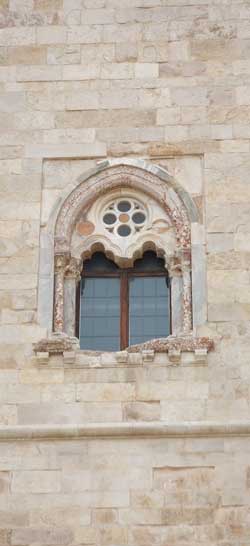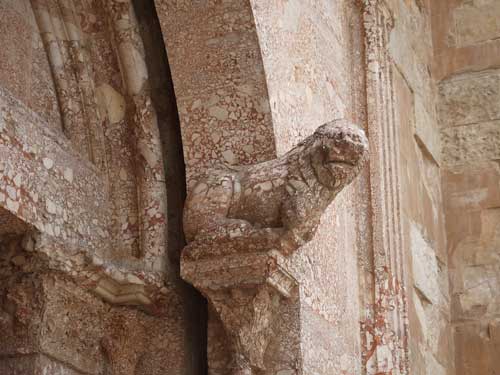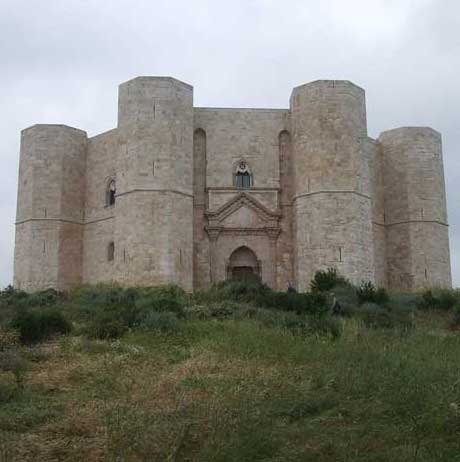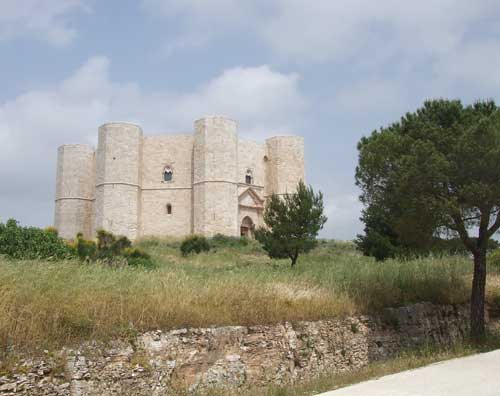About Castel del Monte
Castel del Monte is one of the many castles built in southern Italy in the thirteenth century by Frederick II, Holy Roman Emperor. It’s seen as the greatest of his castles, and is a UNESCO World Heritage site. Normally I’d write about the destination first and the travel details afterwards. However, Castel del Monte is in the middle of nowhere and getting there will be the key thing on visitors’ minds. So here I’ll add detailed information about transport options, followed by information about the castle itself.
We visited Castel del Monte in May 2008. Guidebooks allude to the near-impossibility of reaching the castle without a car, talking without much optimism about seasonal bus services. Visiting a tourist information office in Bari, we were met with dark shrugs and pessimism: “Difficult without a car”. Fortunately we’d done a lot of internet-trawling before our trip and armed with printouts and bravado we set off by train. And maybe we were lucky, for it actually seemed surprisingly straightforward.
How to reach Castel del Monte by public transport
The nearest town to Castel del Monte is Andria, around twelve miles to the north. It’s a pleasant enough town, but Bari or Trani are better overnight bases. From these two towns you can reach Andria by bus or train. From Bari, take the regional railway called the Ferrovie Nord Barese which has a station alongside the mainline train station. Buy your ticket at a kiosk at street level, then head downstairs for the trains, which follow an inland route towards Barletta, reaching Andria after around an hour. Don’t forget to validate your ticket in a machine before boarding. We needed to change carriages halfway through the journey; the conductor was helpful and made sure everyone knew what to do. To arrive in Andria by train from Trani, you should take the mainline FS service to Barletta and change there to the local line. There are also bus services connecting the towns run by a firm called STP.

Bus from Andria to Castel del Monte – our experience: At Andria railway station (to our relief) the man in the ticket office knew about buses to Castel del Monte. We followed his instructions and headed out of the station. A few yards down the road to the left is a bar called Cafe le Plaisir. Here a friendly barmaid sold us bus tickets and confirmed the accuracy of our internet bus timetable. We then returned to the railway station and waited directly outside for the bus. It was nearly twenty minutes late and we feared the worst, but then a smart little minibus turned up and we were on our way.

Timetables and route: The Andria-Castel del Monte bus service is the number 6, which only runs in summer months (April or May to September or October, depending on what timetable you believe). Buses run several times a day, and stop just outside the railway station in Andria. The journey takes around half an hour. From the railway station (‘Stazione Bari Nord’ on the timetables) the bus heads through the streets of Andria and out along the long country road leading to the castle. Just outside the town are some big new houses with high security fences. Further on is a pretty agricultural landscape of olive groves and pasture. The bus winds up towards the castle and stops by the bar-restaurant just below. There were no other tourists on the services we caught: just three workers from the restaurant and two old men returning into Andria after work on the land.
Although our trip went without a hitch, I would strongly recommend that travellers research the latest timetables before setting off. Useful links are included in our links panel on the right – unfortunately not all the official pages are updated very often. We found the most up-to-date timetable online on the Italian-language pages of the council website under the heading ‘Trasporti’, although the Pro-Loco website was also updated a couple of weeks later. Scroll down the council’s ‘trasporti’ page and choose the timetable for ‘Linea 6’; note that the schedule for Sundays and public holidays (festivi) is different and listed after the weekday and Saturday timetable. We started in Bari with the 8:59am train, and then caught the bus service due to pass Andria railway station just after 10:10, and we returned from Castel del Monte – having checked the time with the driver – at 12:20. After this time there was a big gap until the next service.
An hour is sufficient time for seeing the castle, and some of the timetable gaps would maroon you there for far too long. So it’s definitely a good idea to plan the timing of your day. Our excursion started in the early morning in Bari, and after visiting Castel del Monte we caught a train to Barletta for lunch, explored that town, then headed on by rail to Trani before returning to Bari in the early evening. A busy day but proof that you don’t need a car to see this area.
There is an alternative bus connection which runs from Bari, but currently it isn’t a practical option as the bus is only scheduled to stop once a day at Castel del Monte and you’d have to wait till the next morning to return. It is the Bari – Trani – Andria – Minervino – Spinazzola service run by STP (see our links panel for timetables).
Taxis and private hire
If the bus timetables don’t suit your plans, a more flexible option is to hire a taxi. In Andria there is a firm called Tourist Speedy Transfer which offers a private shuttle service to the castle. They will either take you one way or make a return trip allowing you an hour to see the castle. The telephone numbers are +39 368 213234 / +39 347 3762001 (mobile numbers) and +39 0883 559769 (fixed line). The latest information for the service is featured on the town council website- check this for updates.
Driving
If you are driving, you’ll find it much more straightfoward to reach the castle. From Bari take the SP231 as far as Ruvo di Puglia, then branch off on the SP234. From Andria there is a direct road, the SS170, which heads south to the castle. The official car park is located some way down the wooded slopes from the summit. There’s a charge for parking. A rough path climbs to the castle but most visitors will prefer to use the free shuttle bus service.
Castel del Monte: history and background

Frederick II, Holy Roman Emperor and King of Sicily, is one of the most impressive figures in Italian history. Known as ‘Stupor Mundi’ (Wonder of the World) for his learning and culture, he was a Renaissance man ahead of his time. In his court he encouraged the arts and the rediscovery of classical civilisation. He spoke several languages and studied and wrote on a wide range of subjects from astronomy to falconry. Frederick built a string of castles across Puglia, and most of the mighty sea-shore fortresses you’ll come across date to his thirteenth-century reign. Castel del Monte, built around 1240, is the grandest and the strangest. It has no obvious military function, standing alone on a hill with no settlement or port to protect. Instead of standard defensive features the castle has windows and a few impracticably deep arrow slits. Its design is odd, and that coupled with Frederick’s known love of learning has led to all sorts of speculation about meanings and symbolism. The castle is octagonal, with eight octagonal corner towers and eight rooms on each floor, around a central courtyard.
Among Castel del Monte’s strange features is its layout: visitors proceed from one room into another in a ring around the courtyard: upstairs there is a door-less wall meaning you can’t complete the circuit. Gaps carry sound from one part of the building to another. From the first floor, mullioned windows look out over the plains below, with one three-mullioned window facing Andria. The interior was more ornate than it now appears, enriched with carvings, marbles and mosaics. A little of the decoration remains, or has been reinstated, including colourful door frames and fireplaces: it’s enough to give an idea of how grand the building was intended to be.
The castle looks like a crown, and in a sense that’s probably what it is: a symbol of Frederick’s status and power; its dominant position making it visible from afar. Ironically, after Frederick’s death it was used to imprison his heirs. In later years the building was allowed to crumble. By the time the Italian state acquired it and made it into a National Monument in 1876 it was in a pretty poor state and many of the marbles and decorative features had vanished. Restoration has been ongoing ever since including replacement of stonework and recovery of some of the marbles. Nowadays Castel del Monte features on Italy’s one-cent coin.
Visiting the castle
An hour is really all it takes to see the castle. The interior is bare, apart from detailed information boards (mostly in Italian) explaining the building’s history and context. After viewing the inside, it is worth walking around the castle’s exterior. There are lovely views over the green interior of Puglia, dotted with farms, olive groves and sheep grazing in pastures. It’s a peaceful and rural scene: a big contrast to the built-up areas along the nearby coast.
Just below the castle, where the buses stop, is a rough parking area where we found sleeping dogs and a few souvenir stalls selling postcards and cheap gifts. There is a bar/restaurant, although it’s not always open.
At the time of writing the castle is open every day of the week. From March to September the opening hours are 10:15am to 7:45pm, and from October to February the castle is open from 9:15:am-6:45pm. The last admission is half an hour before closing. Entrance costs 3, but is free to over-65s and under-18s. Those aged 18-25 pay half price.
> Hotels and B&Bs in and around Andria
> More Puglia hotels
Useful external links
Andria Comune (Council) website
Andria Pro Loco (Tourist Information)
Ferrotramviaria – Ferrovie Nord Barese (timetables are under orari)
Frederick II (Wikipedia)
